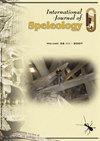连续颜色模型作为改进洞穴年龄模型开发的工具
IF 1.3
4区 地球科学
Q3 GEOSCIENCES, MULTIDISCIPLINARY
引用次数: 0
摘要
由于石笋可以存档各种地球化学指标,并可以用U-Th衰变系列计时器精确测定年代,因此石笋被广泛用于古气候重建。然而,由于U-Th测年在分析上耗时、昂贵,并且需要相对较大的样本量,因此这种计时器的使用受到了限制。这些限制限制了通常获得的绝对日期的数量,这可能会导致年龄模型的显著不确定性,并抑制存档环境变化的高分辨率记录的能力,特别是在那些生长速率变化不受U-Th日期限制的石笋中。在这里,我们探讨了石笋颜色和生长速度之间的关系。因此,我们评估了使用一种简单、实用的非破坏性方法来模拟石笋的年龄-深度关系,使用样品颜色来提供生长速率的连续记录。该方法是通过将高分辨率彩色图像与沿七个石笋生长轴的预定U-Th日期进行比较而开发的。所获得的结果表明,在测年之前,可以使用颜色衍生的连续生长速率模型来识别生长速率的重要变化,这可能有助于确定U-Th测年的最有效位置。此外,U-Th导出日期之间的连续颜色导出插值可能优于传统的线性插值方法。这种方法有可能大大提高研究人员有效选择采样地点的能力,以进行更精确的U-Th测年,尽管这是一种费力和昂贵的方法。本文章由计算机程序翻译,如有差异,请以英文原文为准。
Continuous color model as a tool to improve speleothem age model development
Because they can archive a variety of geochemical proxies and be precisely and accurately dated with the U-Th decay series chronometer, stalagmites are widely used for paleoclimate reconstructions. However, limitations in the use of this chronometer arise because U-Th dating is analytically time consuming, expensive, and requires a relatively large sample size. These limitations restrict the number of absolute dates usually obtained, which can result in significant uncertainties in the age model and inhibit the ability to archive high resolution records of environmental variability, particularly in those stalagmites where there are variations in growth rate not constrained by U-Th dates. Here, we explore the relationship between stalagmite color and growth rate. Consequently, we evaluate the use of a simple, practically non-destructive approach to model the age-depth relationship of stalagmites using the sample color to provide a continuous record of growth rate. The method was developed by comparing high-resolution color images with pre-determined U-Th dates along the growth axes of seven stalagmites. The obtained results suggest that prior to dating, a color-derived, continuous growth rate model may be used to identify important changes in growth rate which may aid in the determination of the most efficacious locations for U-Th dating. Further, continuous color-derived interpolations between U-Th derived dates may be superior to traditional linear interpolation methods. Such an approach has the potential to greatly improve a researcher’s ability to efficiently choose sampling locations for more precise, albeit laborious and costly, U-Th dating.
求助全文
通过发布文献求助,成功后即可免费获取论文全文。
去求助
来源期刊

International Journal of Speleology
地学-地球科学综合
CiteScore
3.10
自引率
23.10%
发文量
12
审稿时长
>12 weeks
期刊介绍:
The International Journal of Speleology has the aim to get cave and karst science known to an increasing number of scientists and scholars. The journal therefore offers the opportunity to all scientists working in and on karst to publish their original research articles or their review papers in an open access, high quality peer reviewed scientific journal at no cost. The journal offers the authors online first, open access, a free PDF of their article, and a wide range of abstracting and indexing services.
 求助内容:
求助内容: 应助结果提醒方式:
应助结果提醒方式:


